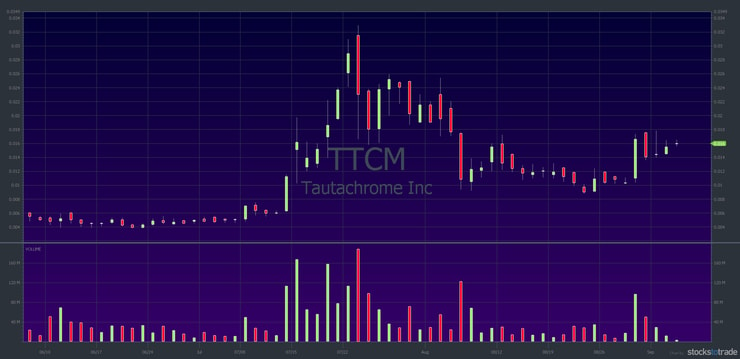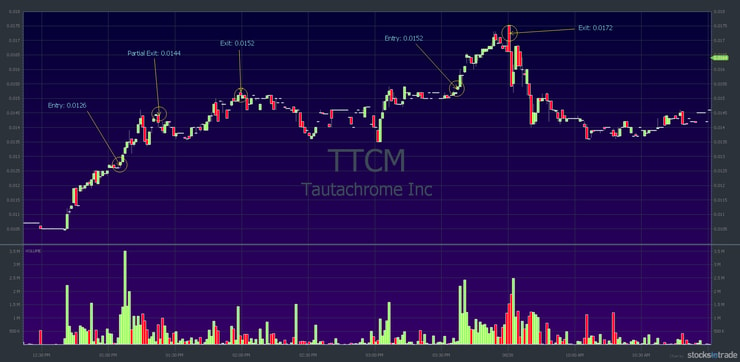If patience is a virtue, then … be virtuous by waiting for the perfect trading setup. Read on for a review of my recent “gimme” on a perfect trading setup … and the patience required to nail it.
Welcome to the latest update. Everything I do in regard to charity and teaching started with trading. If you want to achieve financial freedom — and you’re ready to work your butt off — apply for the Trading Challenge. It’s not easy, but it can be worth it. (Potentially. No promises. It depends on your effort.)
Table of Contents
Important: Hurricane Dorian Bahamas Relief Effort Needs You
Karmagawa co-founder Mat Abad and I announced new donations to help four charities. These charities are working on two urgent and important issues. We’re honored to be able to do this work, but we need more people to get involved. Even if all you can do is share on social media, it helps.
As you know, the Bahamas just took a direct hit from Hurricane Dorian. So Karmagawa donated $10,000 each to World Central Kitchen and Team Rubicon. These charities are on the ground helping Bahamians affected by the devastating storm. As I write, the storm is slamming the South Carolina coast. Our thoughts are with all those affected by the hurricane. Stay safe.
Also, I’m sure you’re aware that fires continue to rage in the Amazon. So we’ve donated $10,000 each to Rainforest Alliance and Earth Alliance to help the rainforest.
Please watch the brief video below:
To understand the impact of Hurricane Dorian on the Bahamas, watch the video clips below. (Please note: the video clips contain distressing images.)
The economy of the Bahamas relies heavily on tourism. When a storm of this magnitude hits, it takes years to recover. They badly need help. First, for basic living conditions and then investment to help bring back the economy.
Please do what you can. Donate directly to the charities mentioned in the post above. Or buy gear from the Karmagawa shop. We donate 80% of all profits to various charities. (The other 20% is used to grow Karmagawa so we can help more deserving charities.)
When you visit the Karmagawa site, sign up for our mailing list to keep up to date with all our projects.
Also, please keep sharing our videos and posts. Help spread awareness about these important issues. Let’s all do our part to make this planet a better place to live.
Kimchi and K-pop
This time, I’m writing from South Korea. As always, I’m savoring the local cuisine. I love kimchi — a spicy dish made with cabbage and other veggies. And I love bibimbap which is a mixed rice dish. I love food.
K-pop Celebrities Put On Their Charity Hats
As you know, much of my travel is related to charity work. During this trip, I’m meeting with K-pop celebrities. I can’t mention specific names, but in the coming months, they’ll be getting involved in charity. It’s very exciting.
K-pop has a huge and growing worldwide following. So they can have a massive influence. It’s always awesome to see influencers work to make the world a better place.
I’m grateful for the opportunity to be a positive influence in the world. And it all started with trading. With that in mind, let’s take a look at a recent trade and then I’ll answer some student questions.
More Breaking News
- SGN Stock Surge: Breakout or Bust?
- American Airlines Stock Drop: Immediate Reactions
- ITUB’s Unexpected Surge: Analyzing the Latest Performance
Trading Lesson: A Perfect Trading Setup Worth Your Patience
I want to review a perfect setup and trade for me that I nailed despite traveling. Study the pattern closely. Reliable setups like these can help take the frustration out of trading. When you over-trade lesser setups … frustration builds. So, develop the patience to wait for the perfect setup.
(My results are not typical. I’ve spent years developing the skills and knowledge to become a successful trader. Trading is inherently risky. Don’t risk more than you can afford to lose. That should keep those litigious types at bay…)
Tautachrome, Inc. (OTCPK: TTCM)
On August 29, Tautachrome issued a press release announcing the status of their pending OTCQB uplisting. Putting it in simple terms, it was news about upcoming news.
Pay attention because you’ll rarely see a more perfect trading setup.
I underestimated TTCM during its runup in July. It more than tripled in a few days. So, while I took some profits along the way, I’ve been waiting for it to show signs it can bounce. It’s been holding right around the key breakout level of a penny a share.
To get an idea of how this developed, first look at the TTCM three-month chart:

This chart was a gimme that needed the right news. Why? It was a former multi-day runner consolidating around a key breakout area.
Now comes the fun part for me — a proud teacher moment. I didn’t spot the news. It was alerted in the Trading Challenge chat room by two or three students. They’re not even top students, but they alerted it within minutes of the press release. So congratulations to Trading Challenge students for making it the most useful chat room on the interwebs.
Back to the trade…
TTCM Showed Several Positive Indicators
This is what I saw with TTCM…
- It’s a former runner.
- It had an upcoming news catalyst. One important point here … they didn’t give an exact date for the uplisting news. They were vague. If they’d said, “we’re announcing news on September 29,” then it wouldn’t be nearly as strong a catalyst. Because they only said “in September” it created some urgency. Clever.
- It was spiking on the midday news.
- It was a strong first green day.
- It had big volume.
- It was off its highs.
- The price action was similar to its previous runs.
Normally I don’t like to trade midday. But I didn’t care because experience helped me recognize it had the power to keep going. So I bought, sold, and then re-bought into the close.
Here’s a TTCM chart showing my entry and exit points:

Get to Know the Price Action
I have some haters who like to say things like, “Oh, Tim just analyzes his trades after the fact.” The reality is that I analyze before the trade, during the trade, and after the fact.
I’m always thinking, “how can I get in tune with this stock and this trade?” One of the reasons for my success with these trades is that I recognized the price action.
There’s great value in analyzing a trade and a stock after you’re out. If you’ve watched a stock — both while in a trade and after you get out — you learn about that stock’s potential future price action. Again, it’s not an exact science. But as always … study the past to prepare for the future. That way you’ll recognize a perfect trading setup when you see it.
Now for some student questions…
Trading Questions from Students
“Tim, I’ve been going through your Pennystocking Framework DVDs. In it, you say to understand the rationale behind each move, don’t just memorize patterns. My question: Do you actively consider what longs and/or shorts are thinking during each trade?”
(You can get your copy of Pennystocking Framework here.)
Yeah, especially with shorts these days.
As you might know, I’m going long almost every time. I think Check out my verified trade here. I sold 1,000 shares at .10 and covered at .53. People asked me why I covered so quickly. Frankly, I’m scared of short selling is very crowded. But that doesn’t mean you shouldn’t think about short selling.
You should think about how the shorts are thinking. The stock market is a battlefield. You have to know your enemy.
I have hundreds of video lessons about short selling. And I think you can have an advantage in learning from me … it’s cool because I’m kinda this double agent. I was a short seller for a long time.
But…
I will always try to teach the most effective strategy in the current market. So a few years from now, I might go back to shorting. Or maybe a few months from now. But right now, short selling is very dangerous. We’ve seen squeezes galore.
Just recently we saw Discovery Gold (OTCPK: DCGD), which was the strongest stock in the market. It was spiking, and I can’t tell you how many short-seller comments I’ve seen over the past few weeks…
“This company’s worthless, it’s going to zero…”
But they’re all wrong. Every single one of them.
Maybe it eventually goes to zero, but you must respect the price action. You have to respect the market environment. (Note: DCGD was featured in my penny stocks to watch August update. It spiked again the first week of September.)
So, yeah, it’s good to think about the other side and think about how wrong they are. Or sometimes they might be right. But for short-sellers, most of the time they’re wrong right now. Just be aware of what the other side is thinking for any trade.
Now for the final question of this edition…
“I’ve been trading for less than a year. Is it better for me to have a detailed trading plan and follow it to a T? Or a general trading plan with some wiggle room?”
For someone who’s been trading for less than a year … you’re still in the testing phase. So you want a detailed trading plan … you want specific instructions but … you can’t have that.
You have to test many different strategies because we’re all different.
Even if you’ve been trading for two or three years, you need a…
Trader’s Mindset: Test, Test, Test
You have to change your mindset. Somebody who’s been trading two, three, or four years … I still consider a newbie. I know they don’t consider themselves newbies. But I have to laugh. I can’t tell you how many traders think they know everything three or four years in. And they can learn the hard way they don’t.
You have to test a lot in the beginning. Every trade is a test. So don’t worry about a detailed trading plan.
That’s not to say you shouldn’t plan your trades. But remember you’re testing. Try short selling first red days. I don’t recommend short selling for newbies or those with small accounts. But sometimes you need to test it to see how it works and understand how the other side thinks.
If you test short selling, stick with small positions and cut losses quickly. Also, study my short selling videos before you start testing. If you aren’t ready to risk real money, paper trade using StocksToTrade. It’s the closest thing to real trading you’ll find because of the way the orders get executed.
Try dip buying morning panics … try buying multi-day breakouts. Try holding for more than a day, a week, or a month. See what suits you best and what works for your personality and your schedule.
Then you can develop a detailed trading plan years from now. By then you’ll have tried nearly everything, and you’ll have a pretty good idea of what you’re best at. You can still be learning. It’s never gonna be an exact science — you’ll never have it all figured out. But it does get easier after a lot of experience and trial and error.
The good news is…
… you can speed up your education.
How to Cut Your Learning Curve
You don’t necessarily have to wait three or four years to learn what you need to know. If you watch all my video lessons and DVDs (and for Trading Challenge students, the archived webinars) … you can speed up the learning curve. That’s how you can get better over time.
Again, I’m NOT advocating trading without a plan. That’s a gunslinger or degenerate gambler mentality. Read this post explaining 5 steps for developing a trading plan.
You should have a basic trading plan. Definitely know your risk. Have a thesis about the trade and its potential reward. Plan to cut losses quickly. Watch as many video lessons as you can about the strategy you’re testing. Then, test with a small position size.
Keep in mind, you will lose. At first, it’s likely you’ll lose more often than you win. There’s no replacement for experience.
Millionaire Mentor Market Wrap
That’s it for this edition of the update. Please do what you can to help those in need by donating to the charities mentioned in this post. If you’re not in a position to help financially, you can still have an impact by following Karmagawa’s Instagram account and sharing the posts. Every share counts.
What are you doing every day to build your knowledge account? Comment below, I love to hear from all my readers!











Leave a reply